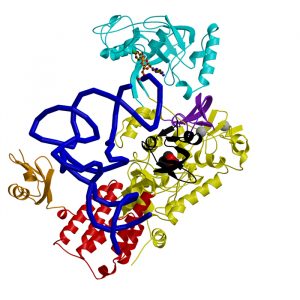New compound effectively treats fungal infections
Researchers unravel how a powerful new compound kills fungi by blocking protein synthesis
A new mechanism to attack hard-to-treat fungal infections has been revealed by scientists from the biotech company Anacor Pharmaceuticals Inc., California, and the European Molecular Biology Laboratory [EMBL] outstation in Grenoble, France. In the current issue of Science they describe how a new compound kills fungal pathogens by blocking an enzyme crucial for their protein synthesis.
The human body is home to many different kinds of fungi. While the majority normally do not harm us, some fungi can cause unpleasant infections of skin, nails or lungs.
“We have discovered a new compound that has the potential to treat common chronic nail infections caused by fungi,” says Dickon Alley, researcher at Anacor Pharmaceuticals. “The compound, called AN2690, kills fungi by blocking their ability to make proteins. It has been very successful in clinical trials.” AN2690 interferes with an enzyme called leucyl-tRNA synthetase, which is involved in translation, one of the last steps in the process of turning a gene’s DNA code into a protein. The process begins when the cell makes an RNA version of the gene’s code, called messenger RNA. Ribosomes, the cell’s protein synthesis machinery, then translate the messenger RNA into protein by stitching together the amino acids in the order specified by the message. This requires the help of molecules called tRNAs, which link the code of the messenger RNA to the correct amino acid.
Leucyl-tRNA synthetase is one of a group of enzymes called aminoacyl-tRNA synthetases that attach the correct amino acid to each tRNA. Some of these enzymes have two main functional parts, or active sites: a site that links the amino acid to the tRNA, and a separate editing site that proofreads this process and removes wrongly added amino acids.
To find out how exactly AN2690 blocks leucyl-tRNA synthetase Stephen Cusack, Head of EMBL Grenoble, and his team generated crystals of the enzyme bound to tRNA in the presence of AN2690. Examining them with the high-intensity X-ray source at the European Synchrotron Radiation Facility, Cusack and his colleagues found that AN2690 sticks in the editing site of the enzyme where it makes a very strong bond to the end of the tRNA, trapping it on the enzyme. This stops the enzyme working and thus blocks protein synthesis, killing the fungal cell. The mechanism crucially depends on a boron atom that is part of AN2690, which is needed to link the compound to the tRNA. It is the first time that scientists describe such a mechanism, suggesting boron containing compounds as a promising new class of drug candidates.
“Now that we know how AN2690 works, the same approach could be adapted to target other aminoacyl-tRNA synthetases with editing sites and also other pathogenic microbes,” concludes Cusack. “We are now working towards finding related antibacterial compounds that could help counter the problem of antibiotic resistance.”




